All you need to know about your products!

| 3DNews Vendor Reference English Resource - All you need to know about your products! |
||||||
 |
||||||
|
|
||||||
nVidia GeForce FX5600 (NV31) Video Card RoundupDate: 05/07/2003
Is nVidia retreating?NVidia's eminent success in 3D graphics is unquestionable, in support of which there's the great number of manufacturers producing video cards based on the popular video chips. The last year was notable for not only the essential growth in the number of partners, but for a serious breakthrough at performance for the mainstream video cards. Recall that the mainstream version of the GeForce 4Ti chip dubbed as 4200 gained its popularity due to the superb 'price/performance' ratio. With the advent of new GeForce FX graphic processors, things have somehow changed albeit far not to the better. While GeForce 4 video cards were taking a serious lead over the predecessors (what is meant is the support for new visualization technologies) at quality and performance, FX products seem to be aimed at merely switching the 3D industry towards DirectX9. At least, while presenting the new line of graphic cards Alan Tike claimed that the company would cease the FPS races and put image quality on the top of the list to maximize the realistic visual experience. With the marketing component skipped off this statement, that means the new products hardly take a lead over the old product lines at performance. This applies primarily to the top-end video cards! But what about the mainstream sector? Let's better not run ahead and rather roundup the FX5600Ultra chip by the example of the MSI FX5600 (MS-8912) video card that is positioned on the mainstream sector, that is meant to come as a replacement to the 4200 and 4400 models. Let's recall the main specifications of the NV31 graphics used in the video card in question:
Here are the official specifications for the MS-8912 video card:
As you see, the clock speeds of the processor and memory are somehow lower than those declared in nVidia's specifications for Ultra models which are to be equipped with 256 MB RAM available in the MS-8912 model. In the end, Microstar made a pretty weird hybrid. Besides, of note is the fact that MSI's FX5600 Ultra video cards have not yet been announced and it looks like we are dealing with an attempt to merge great capacity of slow memory with a slow chip. Anyway, let's leave the reasoning out and go on with the roundup. MSI's value kitA persistent rival of Asustek in the sphere of motherboards and video cards, Microstar has been traditionally notable for expensive products put in pricey package bundles. Usually, the package bundle has a lot of needed and useless software suites, a heap of laces and adapters as well as a pudgy volume of the operating manual giving information on the whole range of current video card lines. In fact, this video card didn't prove to be an exception, and in the rainbow-tinted multicolored box we found all the necessary items, namely:
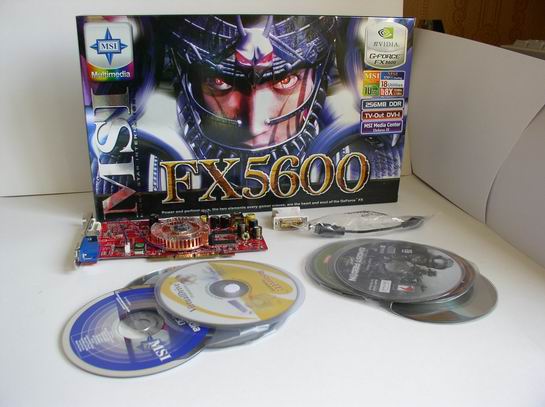 This is to draw the readers' attention that despite many years of operation in Russia, MSI's products have not been often equipped with instruction manuals written in Russian. Mind you, most of the advanced users don't need that care at all, but nevertheless some patriots might take this fact in a not really adequate way. It's about all with describing the package bundle, so let's move on to examining the exterior. The board layoutThis video card is made following MSI's traditional red PCB and in full accord with NVidia's reference design. 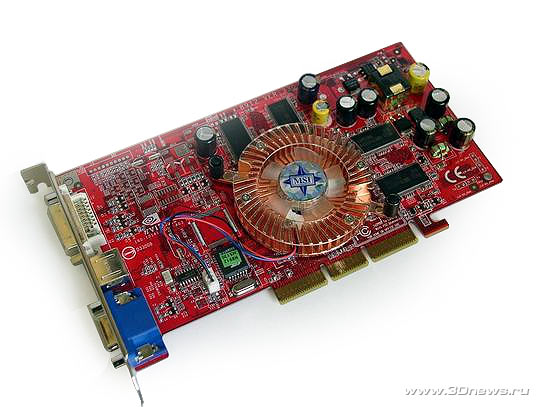 MSI FX5600 (MS-8912) Under the standard propeller with a copper radiator, a "non ultra" GeForce FX 5600 graphics chip was found. 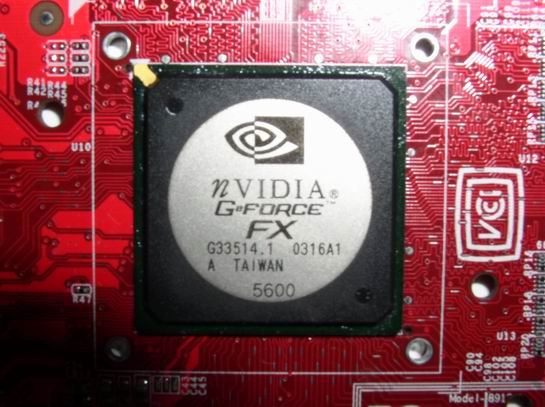 The cooling system also didn't make any difference from the reference, so we are not describing it in detail, but the memory chips merit a closer look. Take a look at the photo! 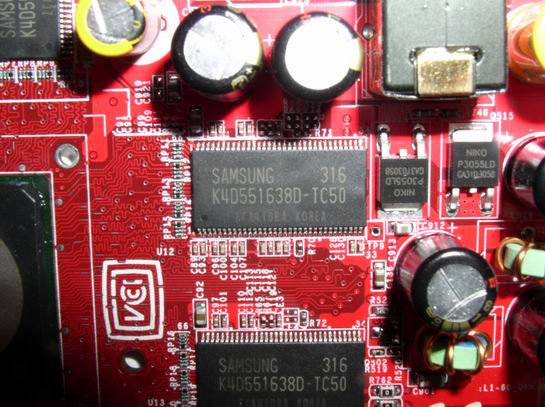 The TC-50 index means that the access time is 5 ns, which is equivalent to 400 MHz. However, the specs for this card says 550 MHz, therefore the memory in MS-8912 runs at increased speed (for the chip), which hardly favors to additional overclocking. Forgive me the readers, but being strongly against any "unnatural manipulations" towards computer components, I will not write a line on that. Overclocking potentials differ essentially even among video cards of the same lot, which may result in angry claims like "I read, trusted and bought it, threw off my money, but the damn rig won't overclock..!" Besides, the "amateur" overclocking spoils hardware, which the author has made sure many times on his own experience. Overclocking the Albatron Geforce 4 TI 4200 video card resulted in a damage to the fan so that the plastic cracked due to overheating. Let's go on reviewing the MS-8912 in the nominal mode.
|
| The chip: | GeForce FX5600 | GeForce 4 Ti4200 |
| RAM capacity | 256 Mb | 128 Mb |
| The graphics core clock speeds: | 325 MHz | 250MHz |
| Memory clock speeds: | 550MHz | 500MHz |
| Memory bandwidth: | 11.2 GB/s | 8 GB/s |
| Output speeds: | 1.4 trln texels/s. | 4 trln texels/s. |
| Vertices per second: | 88 mln | 113 mln |
For performance comparisons, we used the following:
Test configuration:
| CPU | AMD AthlonXP 2500+ (Barton) |
| Motherboard | Epox 8RDA (NForce2) |
| Memory RAM | 512 Mb DDR400 (Dual Channel) |
| HDD | HDD 80Gb IBM IC35L |
| LCD | Bliss 1700RT (max. 1280х1024) |
| Software: | Windows XP Professional + ServicePack 1 Detonator 44.03 |
With the AA disabled, we produced the following results:
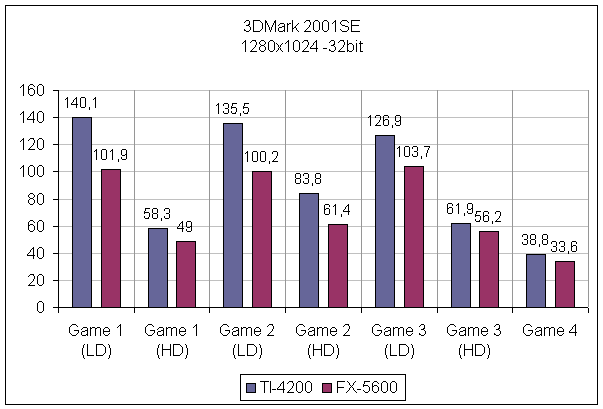
Enabling the AA gives somewhat different results:

As you see, the Ti 4200 evidently lags behind in the former case and gets a very small lead in the latter. What does it show? The card seems to have a good potential, but the existing software does not allow the card to reveal itself to the full. Put into a plain language, this means the 5600 will be of no use to those who are indifferent to anti-aliasing and other "tricks".

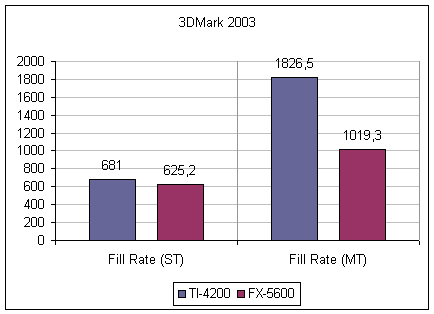
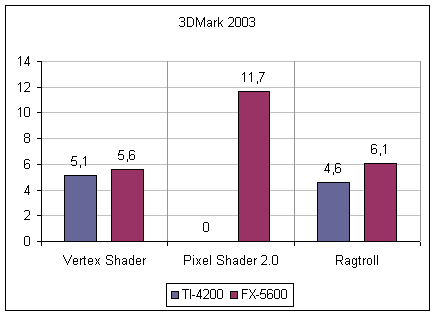
That's just where MS-8912 shows its talents to the full. Along with the support for Pixel Shaders 2.0, the card does quite a good job coping with the remaining DirectX 9 benchmarks, although the results produced are very far from being called "fantastic". The conclusion is pretty interesting, but let's put it aside until the end. Now get on to other benchmarks.
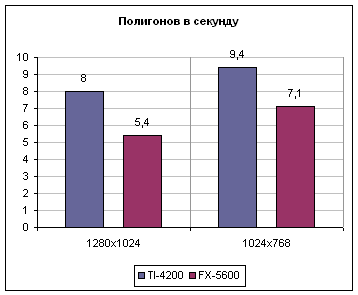

It's absolutely evident that in the DirectX 8.1 benchmark the performance crown is indisputably with Ti4200.
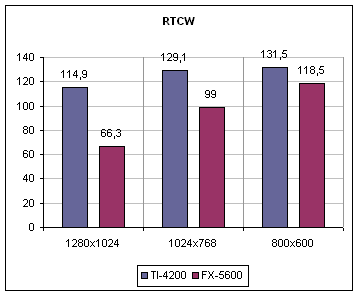
The Ti4200 takes almost as twice a lead over the contender in high resolutions, but at 800x600 the gap is almost void. However, don't forget that as prices for high-resolution monitors go down, the number of low-resolution fanciers is swiftly going down.
The conclusion goes without saying: the MS-8912 is aimed at future potentials of 3D graphics, but in the current applications it is still unable to beat even the Ti4200.
What's more, as the Future Mark 2003 benchmarks show, the FX5600 is not doing very well at DirectX 9 benchmarks either, which is hardly to bring a positive effect on its application in future-generation games. In my view, 11 fps, let alone 6 fps, is too slow for a comfortable gameplay in a dynamic first-person shooter. By the way, specialists at nVidia keep to the same view. At the conference mentioned in the beginning of this roundup, as a reply to one of the journalists' question, Alan Tike pronounced the figure as high as 26 fps. To cut it short, the card proved to be a bit weird, but that we'll tell in the final words which we'll bring in after covering a very important circumstance.
So.. Some readers might ask why the description of image quality with screenshots is missing. As for the 2D graphics, at that there's nothing to complain about in this card of MSI. The same applies to the TV-out. Things with the 3D graphics appear to be somehow difficult, since screenshots are unlikely to serve as the evidence. Evidently, there is a dependence of image quality on the operation of programs that generate it as well as the driver settings in the video card itself. Moreover, the subjective perception of displayed textures prevents a one-one estimation of the video card performance. Of course, there is such thing like realism, but that doesn't relate to a static 3D image but to a moving object due to the lightmaps and dynamics of 3D models. That is vividly seen from the demo reels in the well-known Dawn. Hopefully, in the near future there will be found a way to translate high-quality video for plain objects to demonstrate the card's potentials in action. For now, let's sum it all up.
As the conducted benchmarks showed, the FX5600 chip albeit positioned as a replacement to the GeForce 4 Ti4200 chip can hardly match it. The problem is not only in the lack of software able implementing the DX9 potentials to the full, but also in its slow speed. Besides, having rounded up video cards based on the GeForce FX, you arrive at an unpleasant finding - currently, nVidia offers no good video cards for the mainstream sector. Due to the lack of games demanding GeForce FX to function properly, we believe it is not reasonable to be hasty at upgrading GeForce 4Ti models.
|
|||||